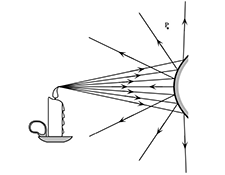
Curved mirrors and multiple reflections
Variant i Dynamics first
This third tutorial on geometrical optics covers ray tracing for large curved mirrors. Image formation by multiple mirrors is also covered.
Topics Waves and optics / Geometrical optics: models, light (or shadow), ray tracing, and geometrical optics
Materials
Materials by the UW team
- Group Handout


- Instructor Guide


- Pretest


- Exam Questions



- Equipment List

Tutorial details
In the first part of the tutorial, students consider a pin that is in front of a convex, semi-cylindrical mirror. They are asked to draw several rays from the pin that are reflected by the mirror. When some students find that the reflected rays do not all appear to have come from the same point, they start to question whether or not they have drawn the reflected rays correctly. The students are led to recognize that in order to determine the location at which a particular observer sees an image, they must draw two rays that reach (or pass near) the observer. Students then consider only a small portion of the curved mirror. They observe that for a small portion of the curved mirror, the image location does not depend significantly on observer location. The observation motives the paraxial approximation.
In the second part of the tutorial, students find the images of a pin that are produced by two plane mirrors held at right angles to one another. Many students have difficulty in accounting for the image that is produced by light that is reflected off of both mirrors.
For instruction tips, login or register as a verified educator to see the Instructor Guide.
Prerequisites
Prerequisite tutorials
The Plane mirrors tutorial is a prerequisite to Curved mirrors and multiple reflections.
Other prerequisites
It is expected that students have worked through the tutorial Plane mirrors. The second homework problem requires an understanding of focal point.
Equipment
Special Instructions
Semi-cylindrical mirrors can be made by taping mylar along the curved side of a semi-cylindrical plastic dish (often used for refraction of light experiments).
Students use stick pins to locate images by parallax, so it is convenient to have semi-circular pieces of cardboard inserted snugly into the bottom of each dish.
Students can align the dish with the handout provided. See the handout, which is based on a dish ~12.5 cm in diameter.
List
- corrugated cardboard ~50 cm × 50 cm
- mirror supports
- plane mirrors
- protractor
- stick pins
- straight edge
- white board or large sheet of paper with markers
- semi-cylindrical mirrors (see Comments)
- ~5 cm × 7 cm
- life-size top-view diagram of semi-cylindrical mirror (See "CVM Handout.pdf")
Research
- F. Goldberg and L. McDermott, An investigation of student understanding of the real image formed by a converging lens or concave mirror, Am. J. Phys. 55 (2), 108 (1987).
Coming Soon! We hope to release the discussion section on each tutorial soon.

